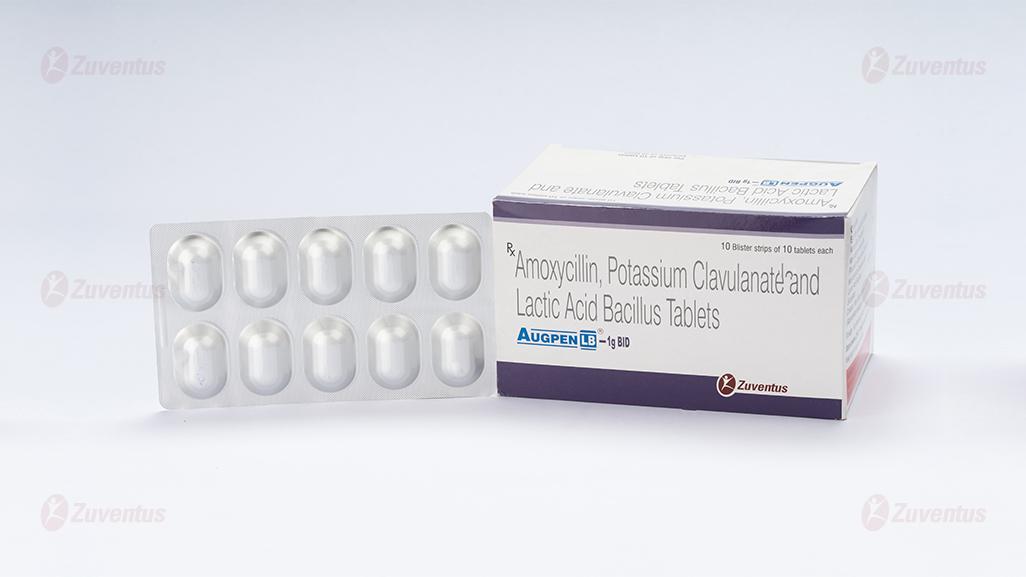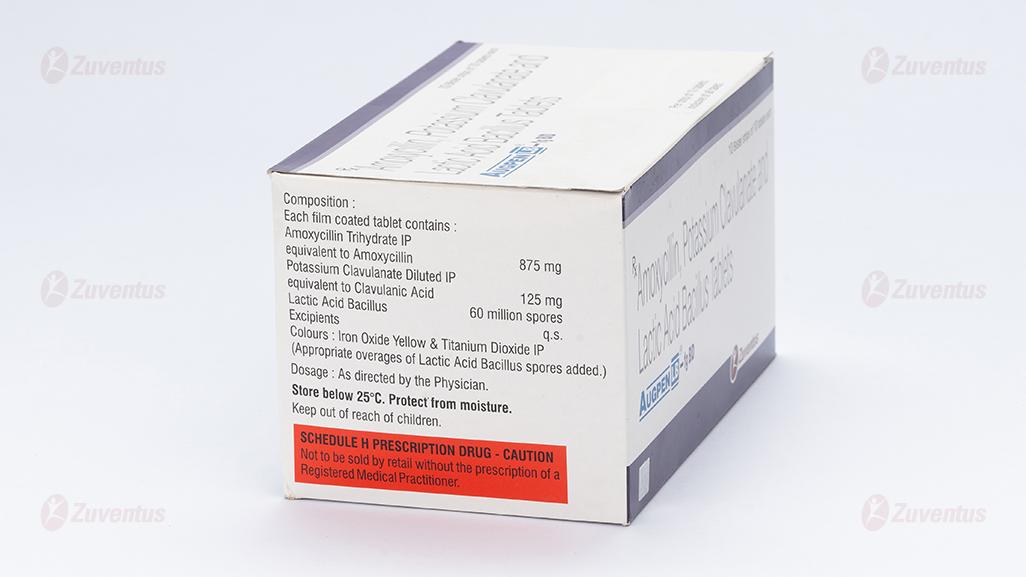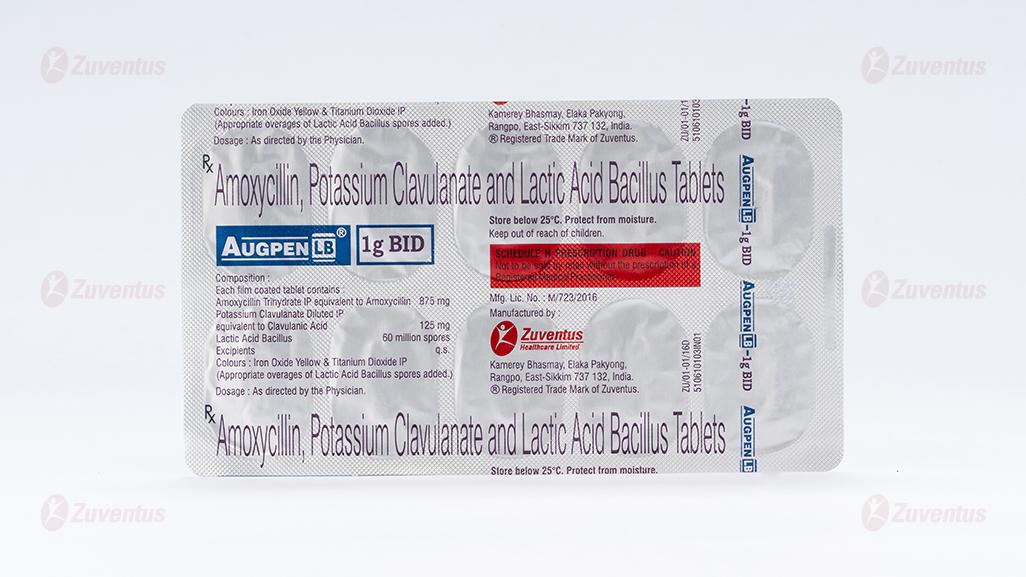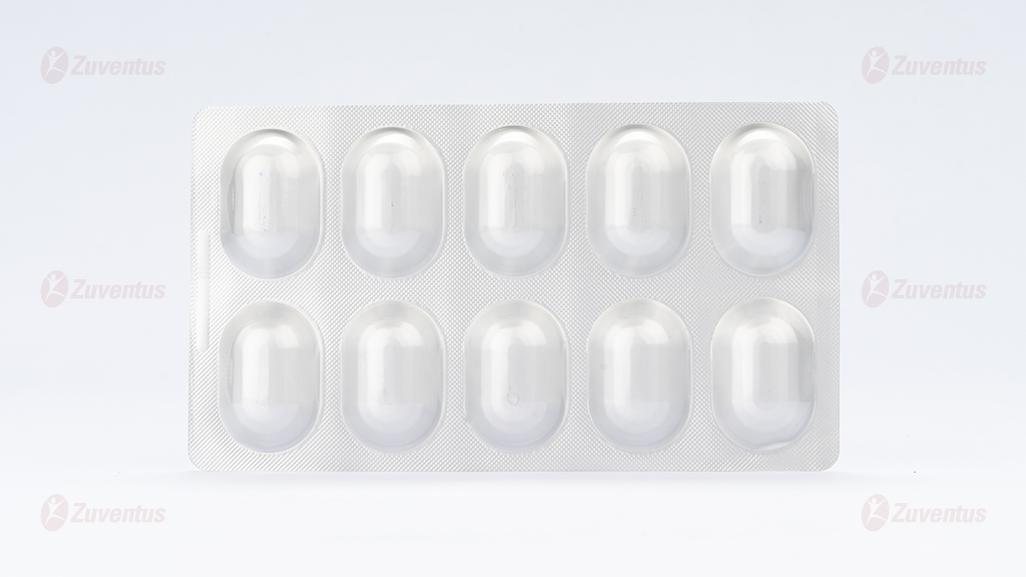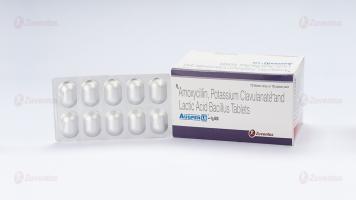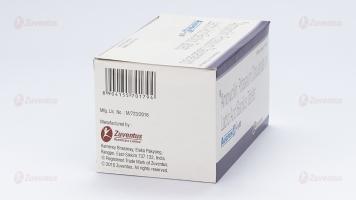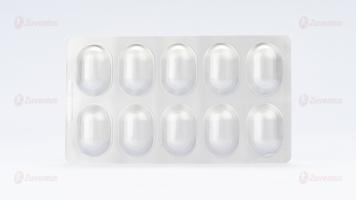Augpen LB- 1 g BID Tablet
Therapy Area
Anti Infective
1.0 Generic name
Amoxycillin, Potassium Clavulanate and Lactic Acid Bacillus Tablets
2.0 Qualitative and quantitative composition
Augpen LB 625 mg
Each film coated tablet contains:
Amoxicillin Trihydrate IP equivalent to Amoxicillin 500 mg
Potassium Clavulanate Diluted IP equivalent to Clavulanic Acid 125 mg
Lactic Acid Bacillus 60 million spores
Excipients q.s.
Colours: Iron Oxide Yellow & Titanium Dioxide IP
(Appropriate overages of Lactic Acid Bacillus spores added.)
Augpen LB 1 g
Each film coated tablet contains:
Amoxicillin Trihydrate IP equivalent to Amoxicillin 875 mg
Potassium Clavulanate Diluted IP equivalent to Clavulanic Acid 125 mg
Lactic Acid Bacillus 60 million spores
Excipients q.s.
Colours: Iron Oxide Yellow & Titanium Dioxide IP
(Appropriate overages of Lactic Acid Bacillus spores added.)
3.0 Dosage form and strength
Film coated tablet, 625 mg and 1 g
4.0 Clinical particulars
4.1 Therapeutic indications
Augpen LB 625mg
For the treatment of bacterial infections such as sinusitis otitis media, tonsillitis, acute and chronic bronchitis, skin and soft tissue infections, pelvic infections, ocsteromylitis, post-operative pain in adults, prone to antibiotic associated diarrhoea.
Augpen LB 1g
For the treatment of mild to moderate bacterial lower respiratory tract infections in adults, prone to antibiotic associated diarrhoea.
4.2 Posology and method of administration
Dosage depends on the age and renal function of the patient and the severity of the infection. To minimise potential gastrointestinal intolerance, administer at the start of a meal. The absorption of Augpen LB is optimised when taken at the start of a meal. Treatment should not be extended beyond 14 days without review. Therapy can be started parenterally and continued with an oral preparation. Tablets should be swallowed whole without chewing. If required, tablets may be broken in half and swallowed without chewing. Augpen LB tablets are not recommended in children of 12 years and under.
Adults and children over 12 years
The usual recommended daily dosage is:
| Mild - Moderate infections | One Augpen LB 625 tablet every 12 hours. |
| Severe infections | One Augpen LB 1g BID tablet every 12 hours |
Renal impairment
No adjustment in dose is required in patients with creatinine clearance (CrCl) greater than 30 mL/min.
The Augpen LB 1g BID tablet should only be used in patients with a creatinine clearance (CrCl) rate of more than 30 mL/min.
| CrCl 10-30 mL/min | One Augpen LB 625 tablet every 12 hours. |
| CrCl <10 mL/min | One Augpen LB 625 tablet every 24 hours. |
| Haemodialysis | One Augpen LB 625 tablet every 24 hours, plus a further one tablet during dialysis, to be repeated at the end of dialysis (as serum concentrations of both Amoxycillin and Clavulanic acid are decreased). |
Hepatic impairment
Dose with caution; monitor hepatic function at regular intervals.
4.3 Contraindications
- Patients with a history of hypersensitivity to beta-lactams, e.g. penicillins and cephalosporins.
- Patients with a previous history of Augpen LB-associated jaundice/hepatic dysfunction.
4.4 Special warnings and precautions for use
Before initiating therapy with Augpen LB, careful enquiry should be made concerning previous hypersensitivity reactions to penicillins, cephalosporins or other allergens. Serious and occasionally fatal hypersensitivity reactions (including anaphylactoid and severe cutaneous adverse reactions) have been reported in patients on penicillin therapy. These reactions are more likely to occur in individuals with a history of penicillin hypersensitivity (see Contraindications). If an allergic reaction occurs, Augpen LB therapy must be discontinued and appropriate alternative therapy instituted. Serious anaphylactic reactions require immediate emergency treatment with adrenaline. Oxygen, intravenous (I.V.) steroids and airway management (including intubation) may also be required. Augpen LB should be avoided if infectious mononucleosis is suspected since the occurrence of a morbilliform rash has been associated with this condition following the use of Amoxycillin.
Prolonged use may also occasionally result in overgrowth of non-susceptible organisms. Pseudomembranous colitis has been reported with the use of antibiotics and may range in severity from mild to life-threatening. Therefore, it is important to consider its diagnosis in patients who develop diarrhoea during or after antibiotic use. If prolonged or significant diarrhoea occurs or the patient experiences abdominal cramps, treatment should be discontinued immediately and the patient investigated further. Abnormal prolongation of prothrombin time (increased INR) has been reported rarely in patients receiving Augpen LB and oral anticoagulants. Appropriate monitoring should be undertaken when anticoagulants are prescribed concurrently. Adjustments in the dose of oral anticoagulants may be necessary to maintain the desired level of anticoagulation. Changes in liver function tests have been observed in some patients receiving Augpen LB. The clinical significance of these changes is uncertain but Augpen LB should be used with caution in patients with evidence of hepatic dysfunction.
4.5 Drug Interactions
Concomitant use of probenecid is not recommended. Probenecid decreases the renal tubular secretion of Amoxycillin. Concomitant use with Augpen LB may result in increased and prolonged blood levels of Amoxycillin but not of Clavulanic Acid. Concomitant use of Allopurinol during treatment with Amoxycillin can increase the likelihood of allergic skin reactions.
There are no data on the concomitant use of Augpen LB and Allopurinol.
In common with other antibiotics, Augpen LB may affect the gut flora, leading to lower oestrogen reabsorption and reduced efficacy of combined oral contraceptives.
In the literature, there are rare cases of increased international normalised ratio in patients maintained on Acenocoumarol or Warfarin and prescribed a course of Amoxycillin. If co-administration is necessary, the prothrombin time or international normalised ratio should be carefully monitored with the addition or withdrawal of Augpen LB.
In patients receiving Mycophenolate Mofetil, reduction in pre-dose concentration of the active metabolite Mycophenolic acid of approximately 50% has been reported following commencement of oral Amoxycillin plus Clavulanic Acid. The change in pre-dose level may not accurately represent changes in overall MPA exposure.
4.6 Use in special populations
Use in pregnant women
Reproduction studies in animals (mice and rats) with orally and parenterally administered Augpen LB have shown no teratogenic effects. In a single study in women with preterm, premature rupture of the foetal membrane (pPROM), it was reported that prophylactic treatment with Augpen LB may be associated with an increased risk of necrotising enterocolitis in neonates. As with all medicines, use should be avoided in pregnancy, especially during the first trimester, unless considered essential by the Physician.
Use in lactating women
Augpen LB may be administered during the period of lactation. With the exception of the risk of sensitisation, associated with the excretion of trace quantities in breast milk, there are no detrimental effects for the infant.
4.7 Effects on ability to drive and use machines
Adverse effects on the ability to drive or operate machinery have not been observed.
4.8 Undesirable effects
Data from large clinical trials were used to determine the frequency of very common to rare undesirable effects. The frequencies assigned to all other undesirable effects (i.e., those occurring at <1/10,000) were mainly determined using post-marketing data and refer to a reporting rate rather than a true frequency.
Infections and infestations
Common: Mucocutaneous candidiasis
Blood and lymphatic system disorders
Rare: Reversible leucopenia (including neutropenia) and thrombocytopenia. Very rare: Reversible agranulocytosis and haemolytic anaemia. Prolongation of bleeding time and prothrombin time.
Immune system disorders
Very rare: Angioneurotic oedema, Anaphylaxis, Serum sickness-like syndrome, Hypersensitivity vasculitis.
Nervous system disorders
Uncommon: Dizziness, Headache
Very rare: Reversible hyperactivity, Aseptic meningitis, Convulsions. Convulsions may occur in patients with impaired renal function or in those receiving high doses.
Gastrointestinal disorders
Adults
Very common: Diarrhoea
Common: Nausea, Vomiting
Children
Common: Diarrhoea, Nausea, Vomiting
All populations
Nausea is more often associated with higher oral dosages. If gastrointestinal reactions are evident, they may be reduced by taking Augpen LB at the start of a meal.
Uncommon: Indigestion
Very rare: Antibiotic-associated colitis (including pseudomembranous colitis and haemorrhagic colitis), black hairy tongue, superficial tooth discolouration has been reported very rarely in children. Good oral hygiene may help to prevent tooth discolouration as it can usually be removed by brushing.
Hepatobiliary disorders
Uncommon: A moderate rise in AST and/or ALT has been noted in patients treated with beta-lactam class antibiotics, but the significance of these findings is unknown.
Very rare: Hepatitis and cholestatic jaundice. These events have been noted with other penicillins and cephalosporins.
Hepatic events have been reported predominantly in males and elderly patients and may be associated with prolonged treatment. These events have been very rarely reported in children. Signs and symptoms usually occur during or shortly after treatment but in some cases may not become apparent until several weeks after treatment has ceased. These are usually reversible. Hepatic events may be severe and in extremely rare circumstances, deaths have been reported. These have almost always occurred in patients with serious underlying disease or taking concomitant medications known to have the potential for hepatic effects.
Skin and subcutaneous tissue disorders
Uncommon: Skin rash, Pruritus, Urticaria
Rare: Erythema multiforme
Very rare: Stevens-Johnson syndrome, Toxic epidermal necrolysis, Bullous exfoliative-dermatitis, Acute generalised exanthematous pustulosis (AGEP), and drug reaction with eosinophilia and systemic symptoms (DRESS).
If any hypersensitivity dermatitis reaction occurs, treatment should be discontinued.
Renal and urinary disorders
Very rare: Interstitial nephritis, Crystalluria
Reporting of suspected adverse reactions
- Reporting suspected adverse reactions after authorisation of the medicinal product is important. It allows continued monitoring of the benefit/risk balance of the medicinal product. Healthcare professionals are asked to report any suspected adverse reactions via email to: www.medico@zuventus.com
- Website: https://www.zuventus.com/drug-safety-reporting
By reporting side effects, you can help provide more information on the safety of this medicine.
4.9 Overdose
Gastrointestinal symptoms and disturbance of the fluid and electrolyte balances may be evident. Gastrointestinal symptoms may be treated symptomatically with attention to the water-electrolyte balance. Amoxycillin crystalluria, in some cases leading to renal failure, has been observed. Augpen LB can be removed from the circulation by haemodialysis.
5.0 Pharmacological properties
5.1 Mechanism of Action
Amoxycillin is a semisynthetic penicillin (beta-lactam antibiotic) that inhibits one or more enzymes (often referred to as penicillin-binding proteins, PBPs) in the biosynthetic pathway of bacterial peptidoglycan, which is an integral structural component of the bacterial cell wall. Inhibition of peptidoglycan synthesis leads to weakening of the cell wall, which is usually followed by cell lysis and death. Amoxycillin is susceptible to degradation by beta-lactamases produced by resistant bacteria and therefore the spectrum of activity of Amoxycillin alone does not include organisms which produce these enzymes. Clavulanic acid is a beta-lactam structurally related to penicillins. It inactivates some beta-lactamase enzymes thereby preventing inactivation of Amoxycillin. Clavulanic acid alone does not exert a clinically useful antibacterial effect. Lactobacillus is an aerobic gram-positive, ubiquitous inhabitant of the human oral cavity, vagina and gastrointestinal tract. It inhibits the colonization of pathogenic bacteria upon the intestinal epithelium.
5.2 Pharmacodynamic properties
The prevalence of resistance may vary geographically and with time for selected species, and local information on resistance is desirable, particularly when treating severe infections. As necessary, expert advice should be sought when the local prevalence of resistance is such that the utility of the agent in at least some types of infections is questionable.
| Commonly susceptible species |
|
Aerobic gram-positive micro-organisms
Aerobic gram-negative micro-organisms
Anaerobic micro-organisms
|
| Species for which acquired resistance may be a problem |
|
Aerobic gram-positive micro-organisms
Aerobic gram-negative micro-organisms
|
| Inherently resistant organisms |
|
Aerobic gram-negative micro-organisms
Other micro-organisms
|
|
$ Natural intermediate susceptibility in the absence of acquired mechanism of resistance. £ All methicillin-resistant staphylococci are resistant to Amoxycillin/Clavulanic acid. 1 Streptococcus pneumoniae that are resistant to penicillin should not be treated with this presentation of Amoxycillin/Clavulanic acid. |
5.3 Pharmacokinetic Properties
Absorption
Amoxycillin and Clavulanic acid, are fully dissociated in aqueous solution at physiological pH. Both components are rapidly and well absorbed by the oral route of administration. Following oral administration, Amoxycillin and Clavulanic acid are approximately 70% bioavailable. The plasma profiles of both components are similar and the time to peak plasma concentration (Tmax) in each case is approximately one hour. The pharmacokinetic results for a study, in which Amoxycillin/Clavulanic acid (500 mg/125 mg tablets three times daily) was administered in the fasting state to groups of healthy volunteers are presented below.
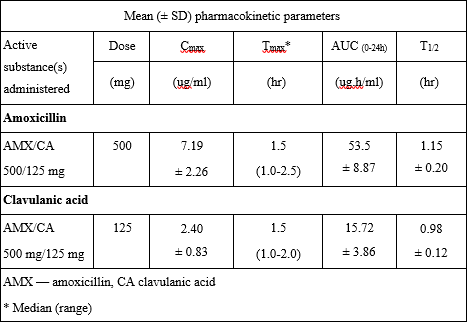
Amoxycillin and Clavulanic acid serum concentrations achieved with Amoxycillin/Clavulanic acid are similar to those produced by the oral administration of equivalent doses of Amoxycillin or Clavulanic acid alone.
Distribution
About 25% of total plasma clavulanic acid and 18% of total plasma amoxicillin is bound to protein. The apparent volume of distribution is around 0.3-0.4 l/kg for amoxicillin and around 0.2 l/kg for clavulanic acid. Following intravenous administration, both amoxicillin and clavulanic acid have been found in gall bladder, abdominal tissue, skin, fat, muscle tissues, synovial and peritoneal fluids, bile and pus. Amoxicillin does not adequately distribute into the cerebrospinal fluid. From animal studies there is no evidence for significant tissue retention of drug-derived material for either component. Amoxicillin, like most penicillins, can be detected in breast milk. Trace quantities of clavulanic acid can also be detected in breast milk. Both amoxicillin and clavulanic acid have been shown to cross the placental barrier.
Biotransformation
Amoxicillin is partly excreted in the urine as the inactive penicilloic acid in quantities equivalent to up to 10 to 25% of the initial dose. Clavulanic acid is extensively metabolized in man and eliminated in urine and faeces, and as carbon dioxide in expired air.
Elimination
The major route of elimination for amoxicillin is via the kidney, whereas for clavulanic acid it is by both renal and non-renal mechanisms.
Amoxicillin/clavulanic acid has a mean elimination half-life of approximately one hour and a mean total clearance of approximately 25 l/h in healthy subjects. Approximately 60 to 70% of the amoxicillin and approximately 40 to 65% of the clavulanic acid are excreted unchanged in urine during the first 6 h after administration of single Augmentin 250 mg/125 mg or 500 mg/125 mg tablets. Various studies have found the urinary excretion to be 50-85% for amoxicillin and between 27-60% for clavulanic acid over a 24 hour period. In the case of clavulanic acid, the largest amount of drug is excreted during the first 2 hours after administration.
Concomitant use of probenecid delays amoxicillin excretion but does not delay renal excretion of clavulanic acid.
6.0 Nonclinical properties
6.1 Animal Toxicology or Pharmacology
No known animal toxicology data.
7.0 Description
Augpen LB is a fixed dose combination of Amoxycillin, a broad spectrum antibiotic, Clavulanic acid, a potent beta lactamase enzyme inhibitor and Lactic Acid Bacillus (Lactobacillus sporogenes species) a probiotic for treatment of infection caused by susceptible bacteria.
8.0 Pharmaceutical particulars
8.1 Incompatibilities
None
8.2 Shelf-life
Refer on pack.
8.3 Packaging information
Alu-Alu blister strip of 10 tablets.
8.4 Storage and handling instructions
Store below 25°C. Protect from light & moisture.
Keep out of reach of children.
9.0 Patient counselling information
- Patients should be informed that Augpen LB may be taken every 8 hours or every 12 hours, depending on the dose prescribed. Each dose should be taken with a meal or snack to reduce the possibility of gastrointestinal upset.
- Patients should be counselled that antibacterial drugs, including Augpen LB, should only be used to treat bacterial infections. They do not treat viral infections (e.g., the common cold). When Augpen LB is prescribed to treat a bacterial infection, patients should be told that although it is common to feel better early in the course of therapy, the medication should be taken exactly as directed. Skipping doses or not completing the full course of therapy may:
- decrease the effectiveness of the immediate treatment, and
- increase the likelihood that bacteria will develop resistance and will not be treatable by Augpen LB or other antibacterial drugs in the future.
- Counsel patients that diarrhea is a common problem caused by antibacterials, and it usually ends when the antibacterial is discontinued. Sometimes after starting treatment with antibacterials, patients can develop watery and bloody stools (with or without stomach cramps and fever) even as late as 2 or more months after having taken their last dose of the antibacterial. If diarrhea is severe or lasts more than 2 or 3 days, patients should contact their physician.
- Patients should be aware that Augpen LB contains a penicillin class drug product that can cause allergic reactions in some individuals.
12.0 Date of issue
06 March 2024
About Leaflet
Read all of this leaflet carefully before you start taking this medicine because it contains important information for you.
- Keep this leaflet. You may need to read it again.
- If you have any further questions, ask your doctor or pharmacist.
- This medicine has been prescribed for you (or for your child) only. Do not pass it on to others. It may harm them, even if their signs of illness are the same as yours.
- If you get any side effects, talk to your doctor or pharmacist. This includes any possible side effects not listed in this leaflet. See section 4.
What is in this leaflet
- What Augpen LB® is and what it is used for
- What you need to know before you take Augpen LB®
- How to take Augpen LB®
- Possible side effects
- How to store Augpen LB®
- Contents of the pack and other information
1. What Augpen LB® is and what it is used for
Augpen LB® is an antibiotic and works by killing bacteria that cause infections. It is a fixed dose combination of three different medicines called amoxicillin, Potassium Clavulanate and lactic acid bacillus.
Amoxicillin belongs to the group of medicines called “penicillins” antibiotics. It works by killing the bacteria and preventing their growth. Sometimes, it can be stopped from working (made inactive) by bacteria. The other active component (Potassium Clavulanate) stops this from happening. Potassium Clavulanate is in a class of medications called beta-lactamase inhibitors. It works by preventing bacteria from destroying amoxicillin. Thus it helps prevent certain bacteria from becoming resistant to amoxicillin.
Lactic acid bacillus, is a type of bacteria commonly found in the human gastrointestinal tract. It is classified as a probiotic, which means it is a beneficial microorganism that helps maintain the natural balance of bacteria (microflora) in the intestines. Amoxicillin can disrupt the natural balance of bacteria in the gut, leading to diarrhea in some individuals. Lactic acid bacillus, by restoring the balance of gut flora, may help reduce the frequency and severity of diarrhea associated with antibiotic use.
Augpen LB® is used to treat the following infections in adults and children 12 years and above who are prone to antibiotic associated diarrhoea:
- middle ear and sinus infections
- tonsillitis, bronchitis, and other respiratory tract infections
- urinary tract infections, pelvic infections
- skin and soft tissue infections including dental infections
- bone and joint infections.
2. What you need to know before you take Augpen LB®
Do not take Augpen LB®:
- if you are allergic to amoxicillin, clavulanic acid, penicillin or any of the other ingredients of this medicine (listed in section 6)
- if you have ever had a severe allergic reaction to any other antibiotic. This can include a skin rash or swelling of the face or throat.
- if you have ever had liver problems or jaundice (yellowing of the skin) when taking an antibiotic.
Do not take Augpen LB® if any of the above apply to you. If you are not sure, talk to your doctor or pharmacist before taking Augpen LB®.
Warnings and precautions
Talk to your doctor or pharmacist before taking Augpen LB® if you:
- have glandular fever
- are being treated for liver or kidney problems
- are not passing water regularly.
If you are not sure if any of the above apply to you, talk to your doctor or pharmacist before taking Augpen LB®.
In some cases, your doctor may investigate the type of bacteria that is causing your infection. Depending on the results, you may be given a different strength of Augpen LB® or a different medicine.
Conditions you need to look out for
Augpen LB® can make some existing conditions worse, or cause serious side effects. These include allergic reactions, convulsions (fits), chest pain and inflammation of the large intestine. You must look out for certain symptoms while you are taking Augpen LB®, to reduce the risk of any problems. See ‘Conditions you need to look out for’ in Section 4.
Blood and urine tests
If you are having blood tests (such as red blood cell status tests or liver function tests) or urine tests (for glucose), let the doctor or nurse know that you are taking Augpen LB®. This is because Augpen LB® can affect the results of these types of tests.
Other medicines and Augpen LB®
Tell your doctor or pharmacist if you are using, have recently used or might use any other medicines.
- If you are taking allopurinol (used for gout) with Augpen LB®, it may be more likely that you will have an allergic skin reaction.
- If you are taking probenecid (used for gout), your doctor may decide to adjust your dose of Augpen LB®.
- If medicines to help stop blood clots (such as warfarin) are taken with Augpen LB® then extra blood tests may be needed.
- Augpen LB® can affect how methotrexate (a medicine used to treat cancer or rheumatic diseases) works.
- Augpen LB® may affect how mycophenolate mofetil (a medicine used to prevent the rejection of transplanted organs) works.
Pregnancy, breast-feeding and fertility
If you are pregnant or breast-feeding, think you may be pregnant or are planning to have a baby, ask your doctor or pharmacist for advice before taking this medicine.
Driving and using machines
Augpen LB® can have side effects and the symptoms may make you unfit to drive. Do not drive or operate machinery unless you are feeling well.
3. How to take Augpen LB®
Always take this medicine exactly as your doctor or pharmacist has told you. Check with your doctor or pharmacist if you are not sure.
Adults and children 12 years and over
The usual recommended daily dosage is:
- Mild - Moderate infections: One or two Augpen LB 375 tablet(s) every eight hours or One Augpen LB 625 tablet every 12 hours.
- Severe infections: One Augpen LB 1g BID tablet every 12 hours.
Augpen LB tablets are not recommended in children of 12 years and under.
To minimise potential gastrointestinal intolerance or side effects, take at the start of a meal. It should not be taken beyond 14 days without review.
Patients with kidney and liver problems
- If you have kidney problems the dose might be changed. A different strength or a different medicine may be chosen by your doctor.
- If you have liver problems, you may have more frequent blood tests to check how your liver is working?
How to take Augpen LB®
- Take with a meal.
- Swallow the tablets whole with a glass of water.
- Tablets can be broken along the score line to make them easier to swallow. You must take both pieces of the tablet at the same time.
- Space the doses evenly during the day.
- Do not take Augpen LB® for more than 2 weeks. If you still feel unwell you should go back to see the doctor.
If you take more Augpen LB® than you should
If you have too much Augpen LB®, signs might include an upset stomach (feeling sick, being sick or diarrhoea) or convulsions. Talk to your doctor as soon as possible. Take the medicine carton or bottle to show the doctor.
If you forget to take Augpen LB®
- If you forget to take a dose, take it as soon as you remember.
- You should not take the next dose too soon, but wait about 4 hours before taking the next dose. Do not take a double dose to make up for a forgotten dose.
If you stop taking Augpen LB®
Keep taking Augpen LB® until the treatment is finished, even if you feel better. You need every dose to help fight the infection. If some bacteria survive they can cause the infection to come back.
If you have any further questions on the use of this medicine, ask your doctor or pharmacist.
4. Possible side effects
Like all medicines, this medicine can cause side effects, although not everybody gets them. The side effects below may happen with this medicine. Conditions you need to look out for
Allergic reactions:
- skin rash
- inflammation of blood vessels (vasculitis) which may be visible as red or purple raised spots on the skin, but can affect other parts of the body
- fever, joint pain, swollen glands in the neck, armpit or groin
- swelling, sometimes of the face or throat (angioedema), causing difficulty in breathing
- collapse
- chest pain in the context of allergic reactions, which may be a symptom of allergy triggered cardiac infarction (Kounis syndrome).
Contact a doctor immediately if you get any of these symptoms. Stop taking Augpen LB®.
Inflammation of large intestine
Inflammation of the large intestine, causing watery diarrhoea usually with blood and mucus, stomach pain and/or fever.
Drug-induced enterocolitis syndrome (DIES)
DIES has been reported mainly in children receiving amoxicillin/clavulanic acid. It is a certain kind of allergic reaction with the leading symptom of repetitive vomiting (1-4 hours after drug administration). Further symptoms could comprise abdominal pain, lethargy, diarrhoea and low blood pressure.
Acute inflammation of the pancreas (acute pancreatitis)
If you have severe and on-going pain in the stomach area this could be a sign of acute pancreatitis.
Contact your doctor as soon as possible for advice if you get these symptoms.
Very common side effects
These may affect more than 1 in 10 people
- diarrhoea (in adults).
Common side effects
These may affect up to 1 in 10 people
- thrush (candida - a yeast infection of the vagina, mouth or skin folds)
- feeling sick (nausea), especially when taking high doses
if affected take Augpen LB® with a meal
- vomiting
- diarrhoea (in children).
Uncommon side effects
These may affect up to 1 in 100 people
- skin rash, itching
- raised itchy rash (hives)
- indigestion
- dizziness
- headache.
Uncommon side effects that may show up in your blood tests:
- increase in some substances (enzymes) produced by the liver.
Rare side effects
These may affect up to 1 in 1000 people
- skin rash, which may blister, and looks like small targets (central dark spots surrounded by a paler area, with a dark ring around the edge – erythema multiforme)
- if you notice any of these symptoms contact a doctor urgently.
Rare side effects that may show up in your blood tests:
- low number of cells involved in blood clotting
- low number of white blood cells. Frequency not known Frequency cannot be estimated from the available data.
- Allergic reactions (see above)
- Inflammation of the large intestine (see above)
- Inflammation of the membranes that surround the brain and spinal cord (aseptic meningitis)
- Serious skin reactions:
- a widespread rash with blisters and peeling skin, particularly around the mouth, nose, eyes and genitals (Stevens-Johnson syndrome), and a more severe form, causing extensive peeling of the skin (more than 30% of the body surface - toxic epidermal necrolysis)
- widespread red skin rash with small pus-containing blisters (bullous exfoliative dermatitis)
- a red, scaly rash with bumps under the skin and blisters (exanthemous pustulosis).
- flu-like symptoms with a rash, fever, swollen glands, and abnormal blood test results (including increased white blood cells (eosinophilia) and liver enzymes) (Drug Reaction with Eosinophilia and Systemic Symptoms (DRESS)).
Contact a doctor immediately if you get any of these symptoms.
- rash with blisters arranged in a circle with central crusting or like a string of pearls (linear IgA disease)
- inflammation of the liver (hepatitis)
- jaundice, caused by increases in the blood of bilirubin (a substance produced in the liver) which may make your skin and whites of the eyes appear yellow
- inflammation of tubes in the kidney
- blood takes longer to clot
- hyperactivity
- convulsions (in people taking high doses of Augpen LB® or who have kidney problems)
- black tongue which looks hairy.
Side effects that may show up in your blood or urine tests:
- severe reduction in the number of white blood cells
Reporting of side effects
If you get any side effects, talk to your doctor, pharmacist or nurse. This includes any possible side effects not listed in this leaflet. You can also report side effects directly:
Website: www.zuventus.com and click the tab “Safety Reporting” located on the top end of the home page.
https://www.zuventus.com/drug-safety-reporting By reporting side effects, you can help provide more information on the safety of this medicine. You can also report the side effect with the help of your treating physician.
5. How to store Augpen LB®
- Keep this medicine out of the sight and reach of children.
- Do not use this medicine after the expiry date (EXP) which is stated on the carton. The expiry date refers to the last day of that month.
- Do not store above 25oC.
- Store in the original pack to protect from moisture.
- Do not use if the tablets are chipped or damaged.
- Do not throw away any medicines via wastewater or household waste. Ask your pharmacist how to throw away medicines you no longer use. These measures will help protect the environment
6. Contents of the pack and other information
What Augpen LB® contains
Augpen LB 625
Each film coated tablet contains:
Amoxycillin Trihydrate IP equivalent to Amoxycillin 500 mg
Potassium Clavulanate Diluted IP equivalent to Clavulanic Acid 125 mg
Lactic Acid Bacillus 60 million spores
Excipients q.s.
Colours: Iron Oxide Yellow & Titanium Dioxide IP
(Appropriate overages of Lactic Acid Bacillus spores added.)
Augpen LB 1g BID
Each film coated tablet contains:
Amoxycillin Trihydrate IP equivalent to Amoxycillin 875 mg
Potassium Clavulanate Diluted IP equivalent to Clavulanic Acid 125 mg
Lactic Acid Bacillus 60 million spores
Excipients q.s.
Colours: Iron Oxide Yellow & Titanium Dioxide IP (Appropriate overages of Lactic Acid Bacillus spores added.)
What Augpen LB® looks like and contents of the pack
Alu-Alu blister strip of 10 tablets.
Manufacturer
Zuventus Healthcare Limited, Kamerey Bhasmay, Elaka Pakyong, Rangpo, East-Sikkim 737 132, India. ®Registered Trade Mark of Zuventus
This leaflet was last revised in June 2024.

